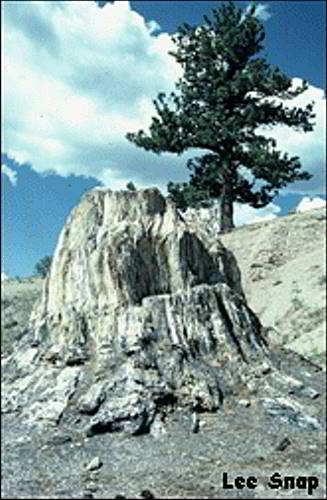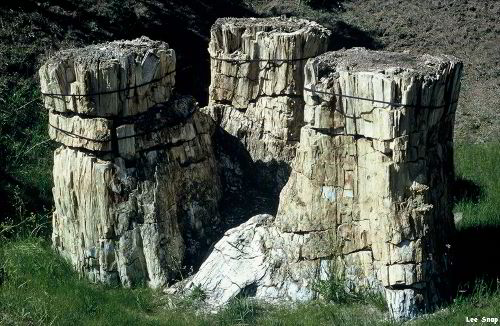|
WNTS/ENTS-
I am soon to visit Colorado for a few days,
and thought I'd research locations appropriate for someone carrying
a Nikon 550, clinometer, and D-tape. Imagine my surprise
when visiting Colorado's big tree registry, that I noted a Sequoia
sempervirens (in itself amazing), with the following dimensions:
Redwood Sequoia sempervirens DBH 131.90"
CBH 414.17" Florissant, Colorado
I should hasten to add, this specimen is a
fossil, found at Florissant Fossil Beds National Monument, at near
10,000' elevation!
-Don
Edward Frank wrote (Sept 8, 2009)
Don,
Florissant Fossil Beds
http://www.nps.gov/flfo/index.htm is a neat place I always meant
to visit. What is most important about the site is the presence of
many insect and spider fossils that are usually not preserved in the
rocks there.

Big Stump This is the Big Stump. The
most common kind of "petrified stump" found at Florissant Fossil
Beds is the redwood Sequoia, such as "Big Stump" pictured at left.
When you visit the park, look for two saw blades embedded into Big
Stump; before Florissant was a National Monument, someone tried to
cut Big Stump into pieces by using saws! Needless to say, the effort
was for the most part, fruitless, and the saw blades are still stuck
in Big Stump to this day!

Trio
This is a fossil set called the Trio. This
"family circle" of fossilized stumps grew out of the single trunk of
an older parent tree. The tree trunks are ancient clones, or
genetically identical copes, of that parent tree. Modern coastal
redwoods also reproduce by stump sprouting. If a redwood is toppled
or burned, a ring of new trees often sprouts from burls (roots that
stick out of the ground) around the trunk's base. In the coastal
redwood forests, family groups are common. But this trio of stone
stumps is unique in the world's fossil record!
http://www.nps.gov/archive/flfo/online_museum/rocks-fossils/paleontology/plants/woods/conifers/trio/index.html
Ed Frank
Continued at:
http://groups.google.com/group/WNTS/browse_thread/thread/351602ccb203e808?hl=en
|